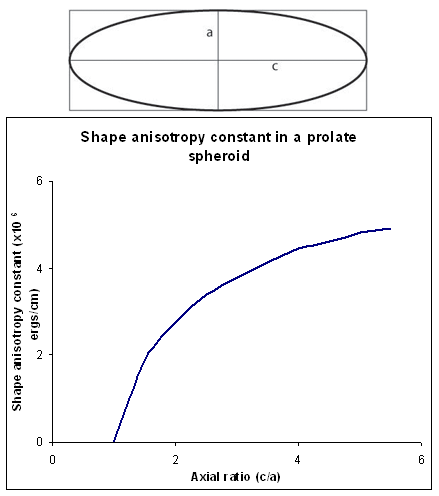Anisotropy
Magnetocrystalline anisotropy
We have already met magnetocrystalline anisotropy in the section about domains where it was stated that there were easy and hard axes in a crystalline material such that a magnetic moment would preferentially orient along the former. The magnetocrystalline anisotropy energy is the energy difference between samples magnetised along the easy and hard directions. It is important to note that the spontaneous magnetisation is the same for both directions but the external applied field required to reach this value is different.
To produce the spontaneous magnetisation the applied field must re-orient the atomic orbital in order to re-orient the direction of the electron spin; this is due to the spin-orbit coupling. The atomic orbitals are strongly coupled to the lattice and so resist the change in orientation. In most magnetic materials the spin-orbit coupling is weak; however in some heavy rare-earth metals the coupling is strong. In the latter case, the resistance to re-orientating the domains away from the easy crystallographic directions is high and requires a large coercive field. Such materials have uses as permanent magnets.
Magnetocrystalline anisotropy decreases with increasing temperature, until at temperatures approaching the Curie temperature there is no preferred orientation of the magnetisation.
Shape Anisotropy in Polycrystals
If a sample is non-spherical it is easier to magnetise with the dipole moments pointing along a long axis. The field required to magnetise the sample must overcome the demagnetising field, which is minimised if it the magnetisation lies along the long axis. The magnetisation produces surface poles, and the magnitude of the demagnetising field decreases as the distance between the poles increases. This therefore has consequences for the shape anisotropy of the sample: the more prolate a sample is, the closer the distance between poles becomes, and the larger the demagnetising field and shape anisotropy is (Figure T).

Figure T. Schematic showing the shape anisotropy constant for a prolate spheroid
Induced Magnetic Anisotropy
It is possible to produce anisotropy in polycrystals by using a treatment with directional characteristics giving texture to the sample. Possible processes include:
- Casting
- Wire-drawing
- Annealing in presence of a magnetic field giving easy axis parallel to applied field
- Rolling

